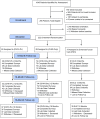Outcomes at 18 Months From a Community Health Worker and Peer Leader Diabetes Self-Management Program for Latino Adults
- PMID: 29703724
- PMCID: PMC6014532
- DOI: 10.2337/dc17-0978
Outcomes at 18 Months From a Community Health Worker and Peer Leader Diabetes Self-Management Program for Latino Adults
Abstract
Objective: This study evaluated the effectiveness of a community health worker (CHW) diabetes self-management education (DSME) program, followed by two different approaches to maintain improvements in HbA1c and other clinical and patient-centered outcomes over 18 months.
Research design and methods: The study randomized 222 Latino adults with type 2 diabetes and poor glycemic control from a federally qualified health center to 1) a CHW-led, 6-month DSME program or 2) enhanced usual care (EUC). After the 6-month program, participants randomized to the CHW-led DSME were further randomized to 1) 12 months of CHW-delivered monthly telephone outreach (CHW-only) or 2) 12 months of weekly group sessions delivered by peer leaders (PLs) with telephone outreach to those unable to attend (CHW+PL). The primary outcome was HbA1c. Secondary outcomes were blood pressure, lipid levels, diabetes distress, depressive symptoms, understanding of diabetes self-management, and diabetes social support. Assessments were conducted at baseline and at 6, 12, and 18 months.
Results: Participants in the CHW intervention at the 6-month follow-up had greater decreases in HbA1c (-0.45% [95% CI -0.87, -0.03]; P < 0.05) and in diabetes distress (-0.3 points [95% CI -0.6, -0.03]; P < 0.05) compared with EUC. CHW+PL participants maintained HbA1c improvements at 12 and 18 months, and CHW-only participants maintained improvements in diabetes distress at 12 and 18 months. CHW+PL participants also had significantly fewer depressive symptoms at 18 months compared with EUC (-2.2 points [95% CI -4.1, -0.3]; P < 0.05). Participants in CHW-led DSME had significant improvements in diabetes social support and in understanding of diabetes self-management at 6 months relative to EUC, but these intervention effects were not sustained at 18 months.
Conclusions: This study demonstrates the effectiveness of a 6-month CHW intervention on key diabetes outcomes and of a volunteer PL program in sustaining key achieved gains. These are scalable models for health care centers in low-resource settings for achieving and maintaining improvements in key diabetes outcomes.
Trial registration: ClinicalTrials.gov NCT00800410.
© 2018 by the American Diabetes Association.
Figures



References
-
- Piette JD, Glasgow R. Strategies for improving behavioral health outcomes among patients with diabetes: self-management, education. In Evidence-Based Diabetes Care. Gerstein HC, Haynes RB, Eds. Hamilton, Ontario, Canada, BC Decker, 2001, pp. 207–251
-
- Norris SL, Chowdhury FM, Van Le K, et al. . Effectiveness of community health workers in the care of persons with diabetes. Diabet Med 2006;23:544–556 - PubMed
Publication types
MeSH terms
Substances
Associated data
Grants and funding
LinkOut - more resources
Full Text Sources
Other Literature Sources
Medical
Miscellaneous

